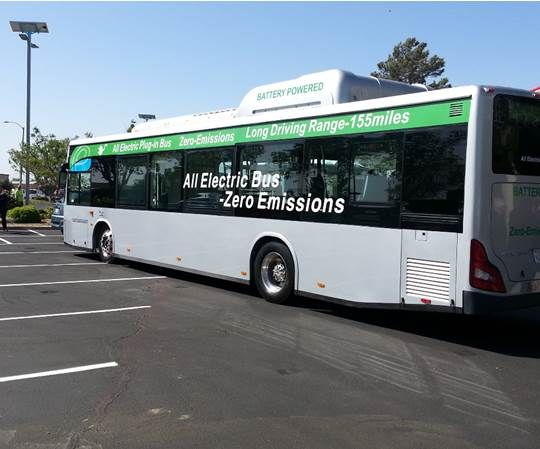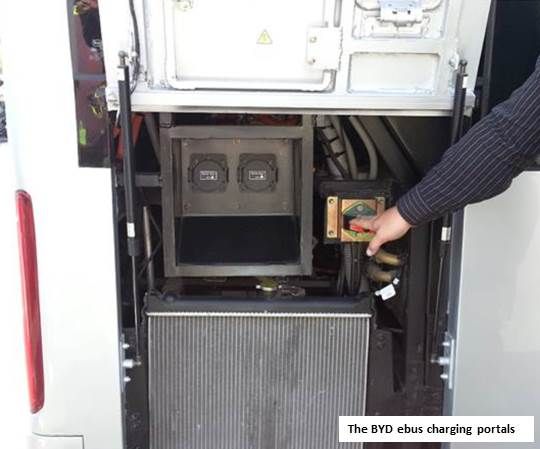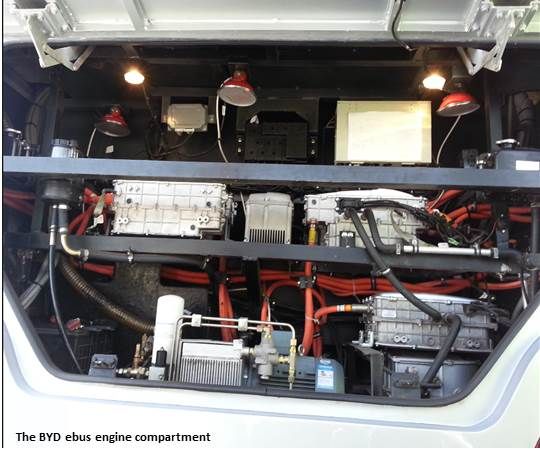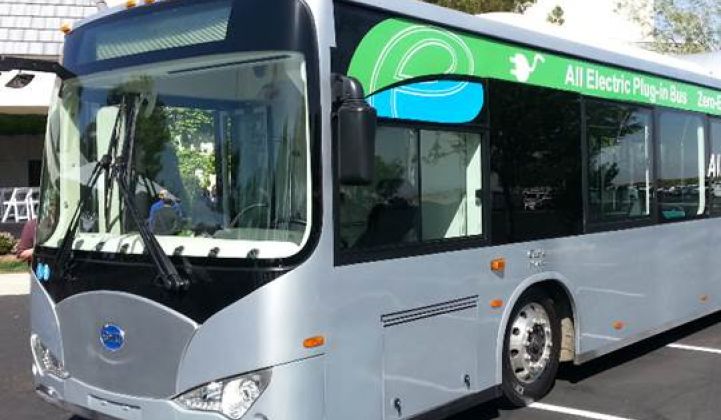The first Chinese vehicle manufacturing facility in the U.S., an electric bus plant, was formally launched by China’s BYD Motors and the City of Lancaster, California. BYD’s local head called on California to alter its utility rates to support electric vehicles.
Scheduled to be ready to begin manufacturing in October, the plant will manufacture BYD’s zero-emissions ebus. BYD’s $50 million commitment, according to VP Michael Austin, will also cover a nearby facility where the electric car maker will manufacture its lithium-ion iron phosphate battery packs.
A 2012 Navigant Research study predicted the world market for electric buses will see a compound annual growth rate (CAGR) of 26.4 percent between 2012 and 2018. Lithium-ion battery capacity for battery buses was predicted to see a 57 percent CAGR, from 69,742 kilowatt-hours to over 1 million kilowatt-hours, in the same time period. It is early to name market leaders, but BYD seems to be among them, with operations around the world.
The 40-foot ebus, which will seat 40 and carry up to 60, will likely cost approximately $800,000 per unit, Austin said. It will have a minimum 150-mile-per-charge range, but has registered 235 miles on a charge when running without air conditioning and with frequent enough stops and starts for the regenerative braking to significantly extend range.

At the launch event, BYD Senior VP Stella Li, who will be in charge of the Lancaster facilities, applauded the Long Beach, California Transit Authority for placing the first ebus order and said BYD expects to fill the $12.1 million, ten-bus contract in May 2014.
Li talked up BYD’s new “Build Your Dream” brand, said the plant will eventually be capable of turning out 1,000 buses per year, and called for other state and U.S. transit authorities “to get on the bus.”
Most significantly, Li also called for California Governor Jerry Brown’s office to obtain an electricity bill rate design change from the California Public Utilities Commission. Li wants California utilities to be able to waive the demand charge part of the electricity bill for nighttime energy used to repower electric vehicles.
The new rate design would require smart meters to identify nighttime consumption as vehicle charging, Li acknowledged, “but it is technology we have. And it could prevent or limit charging during peak demand periods, too.”

During a sample bus ride, Austin compared BYD’s lithium-ion iron phosphate battery chemistry with more common ones using cobalt oxide (typically in laptops), manganese oxide (in the Chevy Volt and Nissan Leaf), and three-metal formulations (still in development).
BYD’s battery is 15 percent less energy dense, he said, but with the space available on the bus and with advanced, lightweight materials, BYD is able to claim comparable economic value.
Buses carry three separate battery packs with a total 324-kilowatt-hour capability per full charge. Each bus has two charge points.
Full charge takes four hours with a fast-charger. The buses are expected to be recharged nightly when in normal municipal bus duty.

Testing suggests the batteries are capable of 6,000 charge-discharge cycles before falling to the 70 percent full recharge level at which they would be decommissioned.
BYD has had 800 buses and more than 800 taxis in service in Asia for three years using the iron phosphate chemistry, Austin said, without any strong indication of operational or safety issues. BYD provides a ten-year warranty.
The calculation is that the batteries will have a longer life, probably twenty years, than the twelve-year expected life of the buses. The company will fully pay for the battery through the return on the vehicle and expects to be able to generate a significant second revenue stream from the accumulated used batteries as bulk storage.
The iron phosphate chemistry, Austin said, makes them thermally stable, even in direct, high-intensity heat.

At an electricity price of $0.10 per kilowatt-hour, BYD claims a $0.20 per mile cost of fuel. It quotes a $1.10 per mile cost for diesel-powered buses and a $0.90 per mile cost for compressed natural gas buses. And the ebus choice allows owners to use whatever powers the grid, be it solar or natural gas, Austin said. The other choices limit owners to one fuel.
Austin said the buses manufactured in Lancaster will have U.S.-made air conditioning units, flooring, seats, audiovisual systems, tires, transmissions and many other parts. The aluminum will come from Alcoa.
Lancaster Mayor Rex Parris, who recently pushed through the first municipal zoning ordinance requiring solar for every new home, called the plant’s launch “historic” and added that “when you put Chinese scientists and U.S. scientists together, there is nothing we can’t do. We can save the planet.”
Noting the ebus can be charged with electricity generated by Lancaster’s ample solar resource, Parris pointed to an ebus nearby. “That is not just clean energy; that is pollution-free.” Then he pointed to a set of sample BYD solar-powered, battery-equipped LED streetlights set up in the parking lot. “They are not connected to the grid. Imagine it: every streetlight could be pollution-free.”




